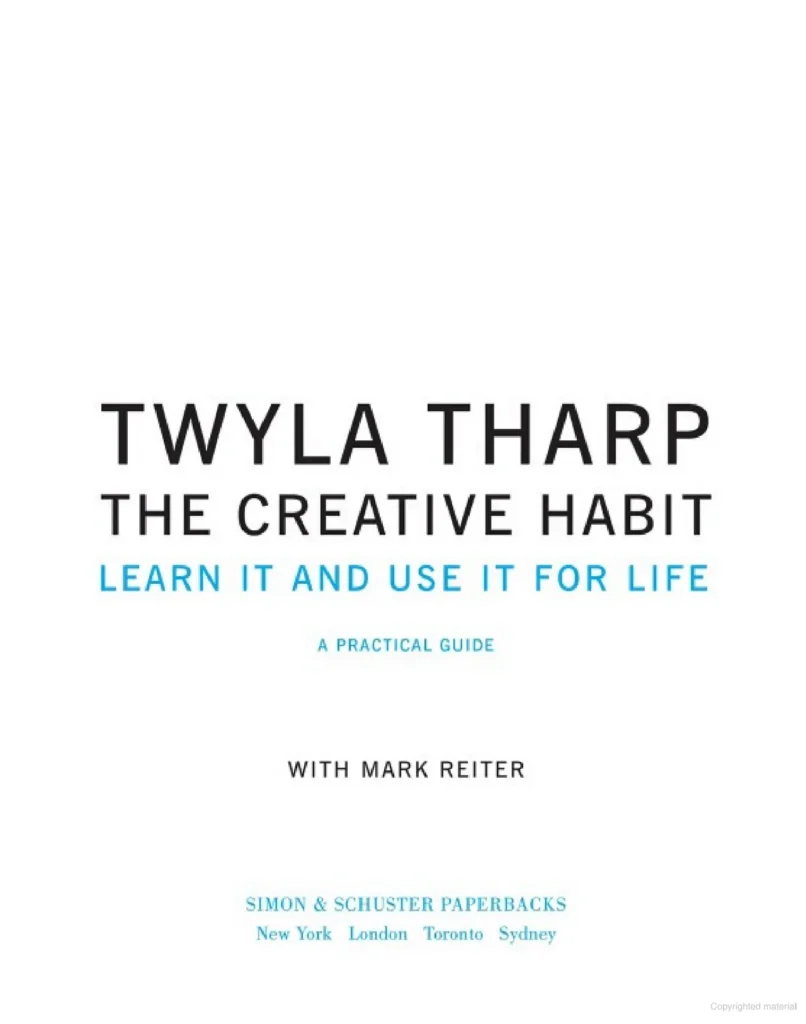
I begin each day of my life with a ritual: I wake up at 5:30 A.M., put on my workout clothes, my leg warmers, my sweatshirts, and my hat. I walk outside my Manhattan home, hail a taxi, and tell the driver to take me to the Pumping Iron gym at 91st Street and First Avenue, where I work out for two hours. The ritual is not the stretching and weight training I put my body through each morning at the gym; the ritual is the cab. The moment I tell the driver where to go I have completed the ritual.
“The Creative Habit: Learn It and Use It for Life” is Twyla Tharp’s masterful exploration of creative process, published in 2003. Drawing from her five-decade career as one of America’s preeminent choreographers, Tharp presents creativity not as mystical inspiration but as habitual practice accessible to anyone willing to develop disciplined routines.
Unlike many creativity books that emphasize spontaneity and “flow,” Tharp’s approach is refreshingly practical and rigorous. Her central thesis challenges romantic notions of creativity: “Being creative is a full-time job with its own daily patterns and routines.” She insists that genius is largely the product of preparation and habit rather than innate talent or sudden inspiration.
The book is structured around specific exercises (“Your Creative DNA,” “Scratching,” “Ruts and Grooves”) designed to develop creative muscles. Each chapter combines memoir, case studies from diverse fields, and concrete practices. Tharp opens by describing her own daily ritual – waking at 5:30 a.m., dressing for work, and hailing a taxi to her gym, a routine that has launched her creative day for decades. This seemingly mundane habit is, for Tharp, a “ritual of preparation” that signals to her body and mind that work is beginning.
For organizing new projects, Tharp introduces her box method – literally starting each new work by collecting physical materials in a dedicated box. She explains: “The box makes me feel organized, that I have my act together even when I don’t know where I’m going yet.” This tangible ritual creates both practical archive and psychological comfort when facing creative uncertainty.
Throughout, Tharp balances demanding discipline with playful experimentation. In “Scratching,” she demonstrates how creatives actively hunt for ideas rather than waiting for inspiration. She describes visiting art galleries, reading books, and watching films as intentional “scratching” for creative sparks, noting that “scratching is what you do when you can’t wait for the thunderbolt to hit you.”
The book addresses creative blocks with particular candor. Rather than offering quick fixes, Tharp presents “the blank page” as an inevitable part of creation that must be worked through methodically. Her chapter “Ruts and Grooves” analyzes the difference between productive routines (grooves) and stifling ones (ruts), offering specific techniques for distinguishing and transforming them.
Tharp confronts perfectionism in her chapter “An ‘A’ in Failure,” arguing that creative growth requires risk and inevitable failure. She provides case studies of her own professional “bombs” alongside exercises for developing resilience through intentional risk-taking.
What distinguishes Tharp’s approach is her insistence on the integration of body and mind in the creative process. As a choreographer, she understands creativity as physical intelligence, not just mental activity. She advocates movement, memory exercises, and other physical practices to develop creative capacity, noting that “being creative involves the body, not just the brain.”
“The Creative Habit” succeeds by demystifying creativity without diminishing its power. Tharp’s voice combines no-nonsense pragmatism with profound artistic wisdom. She rejects the idea that creativity belongs exclusively to geniuses or artists, arguing instead that it’s a fundamental human capacity developed through disciplined practice. Her ultimate message is empowering: creativity is accessible to anyone willing to build the habits that support it, and these habits themselves become the foundation for a creative life.